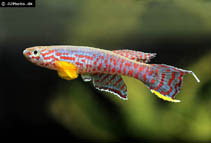| Family: |
Nothobranchiidae (African rivulines) |
| Max. size: |
4.1 cm SL (male/unsexed); 5.5 cm SL (female) |
| Environment: |
pelagic; freshwater, |
| Distribution: |
Africa: Ntem River basin in the Campo-Ma'an region, southern Cameroon (Ref. 80559). |
| Diagnosis: |
Dorsal spines (total): 0-0; Dorsal soft rays (total): 10-11; Anal spines: 0-0; Anal soft rays: 13-14. Diagnosis: Aphyosemion campomaanense is distinguished from congeners by a combination of coloration characteristics (Ref. 80559). It is distinguished from A. ahli by a much more pronounced and darker blue background colour; the background colour is here defined as the colour that covers the majority of the body; in addition, A. ahli has a caudal fin with symmetric colouration while in A. campomaanense the caudal fin colouration is asymmetrical with a yellow lower margin and a white upper margin, vs. red and yellow margins in A. ahli; and the pectoral fins in A. campomaanense are deep orange vs. pale yellow in A. ahli (Ref. 80559). Aphyosemion campomaanense is distinguished from A. lividum by striped dorsal and anal fins vs. unstriped fins; and red dots aligned like vertical stripes posteriorly vs. no red punctuation posteriorly (Ref. 80559). It is distinguished from A. edeanum by an obvious blue vs. reddish background colour; asymmetric caudal fin colouration with a yellow lower margin and a white upper margin vs. red and yellow margins; and deep orange pectoral fins vs. transparent or pale blue (Ref. 80559). It can be distinguished from A. heinemanni by a more pronounced blue background colour; asymmetric caudal-fin colouration with a yellow lower margin and a white upper margin vs. a semicircular red sub-margin on a rounded caudal fin; and the presence of red dots on the anal fin vs. no dots (Ref. 80559). It can be distinguished from A. pascheni pascheni and A. paschane festivum by the presence of vertically aligned red dots in the posterior vs. scattered weak red spotting; red dots on the anal fin vs. no dots; red stripes on the dorsal fin vs. no stripes; yellow lower margins vs. white on the anal and caudal fins; and red vertical stripes on the caudal fin vs. a series of red dots or straight lines or series of dots along rays (Ref. 80559).
Description: There is little sexual dimorphism in body form and allometry in body growth in Aphyosemion campomaanense (Ref. 80559). The dorsal fin deviation to anal fin is the same in male and female: towards the rear, closer to the end of the anal (Ref. 80559).
Colouration: For males the dorsal surface is light brown; the head, laterally pigmented with light blue has three oblique bars on the operculum, a sub-ocular red line and anterior and posterior infrabuccal red bands; the flanks vary from light blue to deep blue with a metallic sheen; two or three horizontal lines of discontinuous red dots extend along the forequarter of the flanks; towards the posterior, red dots merge progressively to create large irregular vertical bars (Ref. 80559). The dorsal fin is blue with dense red stripes forming oblique lines transverse with respect to the rays; the pectoral fins are orange; the anal fin is light blue-green with red stripes forming oblique lines transverse with respect to the rays; on the anal fins of young males are three superimposed longitudinal marginal bands of red, white and yellow; the external yellow band is not always present; the caudal fin colouration is asymmetric, background colouration is light blue with broad vertical red bands, which exhibit high individual variation in terms of number and shape, te upper margin is white with on or three rays often extending to form a long extension, the lower margin is yellow with a sword-like extension; the fin colouration pattern on the pelvic fins is identical to that of the anal (Ref. 80559). Females have a grayish yellow body on which two horizontal bands of red dots are present on the anterior third of the body and narrow brown vertical stripes on the posterior two-thirds; two or three oblique red bands are present on the operculum (Ref. 80559). All fins except pectorals have pale yellow glints; red-brown inter-radial dots are densely and regularly spread throughout the dorsal and the caudal fins; on the caudal fin, these dots are distributed in concentric arcs; the anal fin shows traces of interradial stripes; the pelvic fins are edged with light blue glints (Ref. 80559). Preserved in ethanol body light grey in the posterior part and around the belly to dark grey in the dorsal area; all red spots of live specimens remain; the yellow colour in the male caudal-fin turns to white; the pectoral fins are transparent in both sexes (Ref. 80559). |
| Biology: |
Usually found in small streams and shallow pools in the rainforest; they stay close to the banks, avoiding the deepest and fastest water (Ref. 80559). |
| IUCN Red List Status: |
Not Evaluated (N.E.) Ref. (130435)
|
| Threat to humans: |
harmless |
Source and more info: www.fishbase.org. For personal, classroom, and other internal use only. Not for publication.

